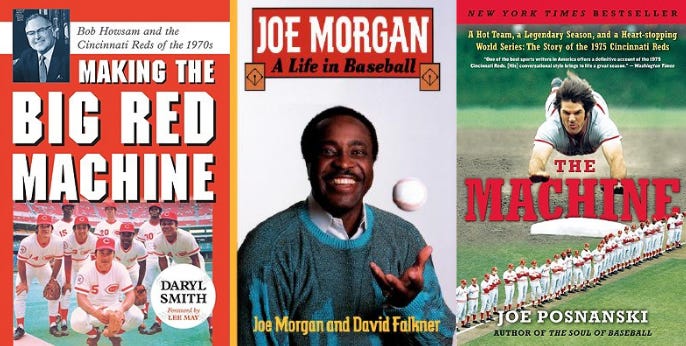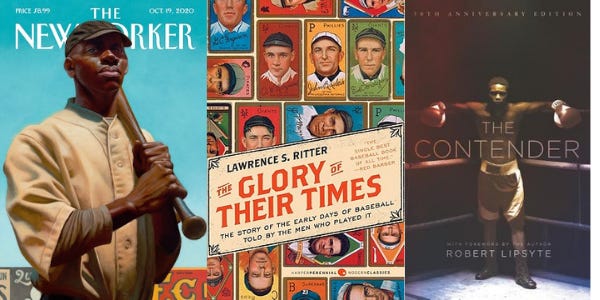The Little General of the Big Red Machine
The Cincinnati Reds' trade for Joe Morgan solidified a dynasty

Sports Biblio Reader 10.18.20
The Imagination of Sports in Books, History, the Arts and Culture
Also In This Issue: Robert Lipsyte; The Strain of NBA Bubble Life; The Masters in Late Autumn; ‘The Glory of Their Times’ Gets a Sequel; The New Yorker Salutes the Negro Leagues; Lindsey Nelson; Billy Beane; Al Davis; Remembering a Palestra Legend
This isn’t supposed to be a newsletter about sports greats who have died, although we do pay tribute to them frequently, usually before closing out an issue.
But in recent weeks, it’s been hard to absorb the losses of five baseball Hall of Famers who’d form the core of a heck of an all-time team: Tom Seaver, Lou Brock, Bob Gibson, Whitey Ford. Earlier this year, Al Kaline.
This week, as the league championship series got underway, the first of the “Great Eight” of the Cincinnati Reds’ Big Red Machine became the latest.
Joe Morgan, who was 77 when he died of undisclosed causes, came to the Reds in a trade with the Houston Astros in late 1971. Cincinnati was a year removed from a World Series with a core of Pete Rose, Johnny Bench, Tony Perez and George Foster.
Those were some big bats, but the diminutive (5-foot-7) Morgan added some difference-making power to the lineup in replacing the light-hitting second baseman Tommy Helms, who was shipped to Houston with Lee May. The trade also brought centerfielder Cesar Geronimo and starting pitcher Jack Bellingham to Cincinnati.
The Reds lost the ‘72 Series to the Oakland A’s, who were in the process of a three-peat, and then Morgan stepped up for his biggest seasons. The dominating “Big Red Machine” won the World Series in 1975 and 1976, the first for the franchise since 1940.
Morgan was Most Valuable Player in the National League in both of those seasons, and he was a first-ballot inductee to the Baseball Hall of Fame in 1990. Ironically, that was the last time the Red have made an appearance in the World Series.
Younger fans knew him as an occasionally annoying color commentator for ESPN, and he admittedly never warmed up to the sabermetrics revolution. Morgan’s 22-year career included 268 home runs, 1,133 RBI, 2,517 hits, a batting average of .271 and five Gold Gloves to go with his 2 MVPs.
When he finally went to Cooperstown, Morgan told Terry Gross in 1993, he was overcome with emotion:
“And to stand there, I guess, with all the greatest players in the world behind you who've ever lived—like Ted Williams, Willie Mays, Stan Musial—and to have to talk about Joe Morgan was very difficult, because in my own mind, you know, I will never, I guess, be able to compare myself to Willie Mays or Stan Musial or Mickey Mantle because, to me, that's when I was a kid. Growing up, these people were, like, not real. They were superhuman people. And that's still a problem for me. It really is. And I think of myself as being—you know, I say that they left big, big footprints and I only left a small one. But however small, when you go to the Hall of Fame, I'm sitting right next to them.”
As noted at FanGraphs this week, while Morgan wasn’t the biggest fan of advanced stats, they’ve helped make many contemporary cases for him as the best second baseman in the history of the game, in the same company as Rogers Hornsby, Jackie Robinson, Rod Carew, Eddie Collins and Nap Lajoie.
For further reading:
Joe Morgan: A Life in Baseball, Joe Morgan with David Falkner
Making the Big Red Machine, by Darryl Smith
The Machine, Joe Posnanski
A Few Good Reads

This week’s cover of The New Yorker magazine is an homage to the Negro Leagues as it closes out its Centennial year. African-American sports artist Kadir Nelson, in fact, has named his art work “The Centennial,” and in a Q & A said he wanted to evoke a timeless image and pose for his nameless subject. Like other paintings Nelson posed for this one as well. His influences are Thomas Eakins, John Singer Sargent, Henry Ossawa Tanner, Velázquez, Charles White, and Norman Rockwell;
Sports author Peter Golenbock announced this week he’s publishing a new baseball book in the spring that’s in the vein of “The Glory of Their Times,” Lawrence Ritter’s acclaimed oral history of stars from the early 20th century. Golenbock’s focus for what he’s tentatively titled “Whispers of the Gods” are players from the 40s-60s and include Roy Campanella, Ted Williams, Stan Musial, Monte Irvin and Ron Santo. Golenbock admitting the appeal to Golden Age nostalgia and said he was posting the news on social media now “because in today’s new world of publishing, publishers do exactly nothing to publicize their books. They are counting on authors to do that;”
From earlier this year, a portrait of the late sports announcer Lindsey Nelson, who was one of the early familiar voices on American television and whose colorful plaid sports jackets were as memorable as his “Hello Everybody, I’m Lindsey Nelson” sign-on;
Longtime Oakland A’s general manager Billy Beane may be leaving the ranks of hands-on management given his interest in an ownership stake with the Boston Red Sox, which prompted Neil Payne of FiveThirtyEight to assess the “Moneyball” mastermind’s legacy and influence;
A new 3D-printed Al Davis torch graces the new home of the Raiders in Las Vegas, nine years after his death. The shiny new object stands nine stories high, with LED-illuminated flame effects, and is said to be the largest 3D-printed object in the world;
As an addendum to the destruction of the minor leagues, the new sports business website Sportico reports this week about an insurance feud involving the New York Yankees AAA farm team in Scranton-Wilkes-Barre, Pa. The claim is one of 20 filed by minor-league clubs seeking financial relief from the entire cancellation of their 2020 seasons;
Retired college basketball coach and longtime Nike executive George Raveling was a graduate of Villanova University in August 1963 when he got a job working security for a major civil rights march and rally in Washington. After Martin Luther King Jr. gave his famous “I Have a Dream Speech,” Raveling asked the civil rights leader if he could have his copy of the remarks. King complied, and to this day, Raveling isn’t sure why he did that: “It took quite a few years for me to really understand the historic significance of it;”
The Los Angeles Lakers left the NBA bubble with their 17th championship—tying them with their ancient rivals Boston Celtics—but the strain of being in such a cloistered environment for several months took an emotional toll. Said Clippers’ forward Paul George: “I underestimated mental health, honestly, I had anxiety, a little bit of depression, just being locked in here. I just wasn’t there. I checked out;”
The Masters was delayed until November due to COVID, and the lack of azaleas won’t be the only thing missing from what typically is the PGA’s first major of the year. As Scott Michaux writes at the Golf Global Post, Augusta National in the early fall will have a very different feel, and some of its denizens have mixed feelings.
Now Hear This
At his SABRcast, Rob Neyer welcomes singer-songwriter Scott McCaughey, and they discuss a historical catalog of baseball songs and the latter’s contributions to “The Baseball Project,” a baseball ballad-lover’s delight;
For the boxing-related touristinfopod, Brin-Jonathan Butler talks to sports journalist and author Robert Lipsyte about his career, including his coverage of Muhammad Ali and books including “The Contender,” considered a standard-bearer for sports-related young-adult fiction.
Passings
Jack Scheuer, 88, remains the all-time leading scorer in the history of the Palestra, Philadelphia’s venerable college basketball shrine. And for decades after graduating from the University of Pennsylvania, he was a regular on press row as an Associated Press correspondent. He was there as late as February, shortly before COVID abruptly halted the college basketball season, and as John Feinstein was publishing his latest book. “The Back Roads to March” is dedicated to Scheuer and another Philly basketball legend, sportswriter and author Dick “Hoops” Weiss.

The Sports Biblio Reader e-mail newsletter is delivered on Sunday. You can subscribe here and search recent archives. The full archives for Sports Biblio Digest can be found here. This is issue No. 221, published Oct. 11, 2020.
I’d love to hear what you think about Sports Biblio. Send feedback, suggestions, book recommendations, review copies, newsletter items and interview requests to Wendy Parker at sportsbiblio@gmail.com.Sports Biblio is an affiliate of Bookshop, an online book retailer, and receives a small commission for books sold via this newsletter. Bookshop donates some its proceeds to independent bookstores across the U.S., so when you shop here you’re supporting a small business in your community.



